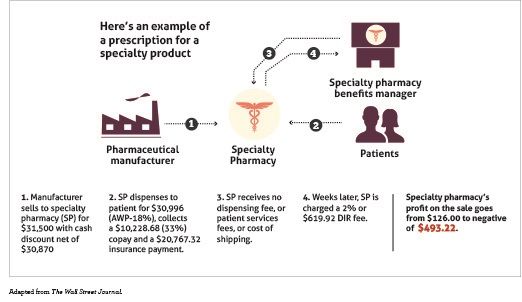Publication
Article
Specialty Pharmacy Times
Tweeting This Out: Build a Wall Around DIR Fees and Make Specialty Pharmacy Great Again
If direct and indirect remuneration fees are to remain, the health care system must recognize that specialty pharmacies provide different services to patients.
There is an oft-repeated saying that warns, “The road to hell is paved with good intentions.”
The initial purpose of direct and indirect remuneration (DIR) fees was to lower beneficiary premiums related to the Medicare Part D benefit. DIR fees address price concessions that would ultimately affect the gross prescription drug costs of Medicare Part D plans not captured at the point of sale. 
DIR fees, however, have expanded beyond the original intent. Frankly, the premise for DIR fees is built around traditional retail pharmacy, and has proven problematic to the patient care services and high drug-cost environment of specialty pharmacy.
Square Peg, Round Hole
DIR has become an all-inclusive acronym designed to capture multiple and non-aligned financial drivers and metrics that do not fit specialty, including so-called pay-to-play fees for network participation and periodic reimbursement reconciliations. DIR fees can be calculated in a variety of ways, including as a percentage of the ingredient cost, a flat-dollar amount, or the difference between the adjudicated reimbursement amount and the agreed-upon reimbursement amount, which, if lower than the adjudicated amount, is used to keep the DIR amount confidential from pharmacy benefit managers (PBMs) and other plan sponsors.
DIR fees may also refer to a payment mechanism of pharmacies for the fulfillment of various quality measures or, alternately, a fee assessed to pharmacies for noncompliance with quality measures. These metrics just do not fit the specialty pharmacy model, where the cost of services is high, patients do not use generics as a rule, and specialty products are priced much higher than retail products.
Quality measures related to chronic diseases and the products that treat them, such as statin-based cholesterol management, diabetes management, and high blood pressure management, gauge the rate of 90-day fills. Margins are also different in specialty and, as a percent of revenue, much lower. Often, DIR fees are calculated across a spectrum of providers, such as retail and specialty. When the fee is applied as a percentage of wholesale acquisition cost, the high price tag of the product puts the specialty pharmacy margins upside down.
Can’t Run a Business This Way
A well-run business requires a predictable and replicable financial platform that allows for planning and forecasting. In 2016, CMS required organizations managing Part D to include in their calculations any rebates or price concessions that may be negotiated with manufacturers, or cost-sharing the patient may have with the payer, as part of their full wholesale acquisition price, which is not the true net price.
This represents an additional expense to the patient. These processes were designed to manage Part D costs in a traditional retail setting. Specialty pharmacies generally do not have access to the price concessions that ultimately flow back to Part D providers. Subsequently, when DIR fees are passed back to the specialty pharmacy from Part D service providers, they are unpredictable and significant. This is not a way to run a rational business. Given that these fees are Part D, they fall under the drug benefit that is managed by PBMs.
The payer and PBM-owned specialty pharmacies are not affected by DIR fees. As a result, other specialty pharmacies may be economically disadvantaged and, in some cases, patients may not have access to the same types of services often provided by independent specialty pharmacies. Furthermore, market competition could be at risk.

Suggested Next Steps and Improvements
If DIR fees are to remain, the health care system must recognize that specialty pharmacies provide different services and products to patients. Specialty pharmacies are well accustomed to having high standards and rigorous quality, and other metrics imposed on them by the marketplace.
The metrics and standards need to be reflective of the services performed and established by the system. If payers and PBMs cannot determine these at the point of sale, then it is not reasonable to penalize the specialty pharmacy through inappropriate DIR fees. Do not use administrative tools that work in retail but not specialty, such as generic fill rates and 90-day fills.
Be proactive and develop a system to calculate the negotiated price. Tactically, some suggestions include developing clear and predicable reimbursement schemes for specialty pharmacies. That would also include specialty products that may have a co-insurance element for the patient being eliminated from the calculation.
Another suggestion is paying pharmacies using 2 standards:
• Use a cost of goods calculation based on true pharmacy acquisition pricing.
• A services component based on standardized quality measures that are quantifiable and relevant to improving patient outcomes.
• Services that motivate higher levels of clinical and operational performance, and allow payment to be rendered based on achievable clinical measures applicable to the practice of specialty pharmacy.
The movers and shakers of pharmacy such as The National Association of Specialty Pharmacy (NASP), National Association of Chain Drug Stores, and National Community Pharmacists Association are working on their various constituents, with NASP leading the charge for specialty. All of these groups are advocating legislators for change. Without relief in the short term, then a moratorium on DIR fees would be a prudent gesture by the Trump administration.
We not only want to “Make America Great Again,” we want specialty pharmacy to stay great! We welcome your feedback on any topics, you would like us to cover in future editions of Specialty Pharmacy Times®.
Please reach out to me at [email protected]. And we also encourage you and your colleagues to subscribe to this unique journal by logging on to www.specialtypharmacytimes.com.

MR. STEIBER formerly operated a consulting practice and was responsible for commercial operations and trade-supply chain strategy development. Mr. Steiber has served in several senior positions in pharmacy, distribution, and industry over the course of his 40-year career. Mr. Steiber is a licensed pharmacist in Texas, Washington, California, and Pennsylvania. He is affiliated with several professional associations and publications and a frequent speaker on behalf of many professional organizations. Mr. Steiber graduated from Washington State University College of Pharmacy. He has participated in a variety of postgraduate programs in law and business development/marketing at Harvard University and Northwestern University. Mr. Steiber currently resides in Highland Village, Texas.

Newsletter
Stay informed on drug updates, treatment guidelines, and pharmacy practice trends—subscribe to Pharmacy Times for weekly clinical insights.






